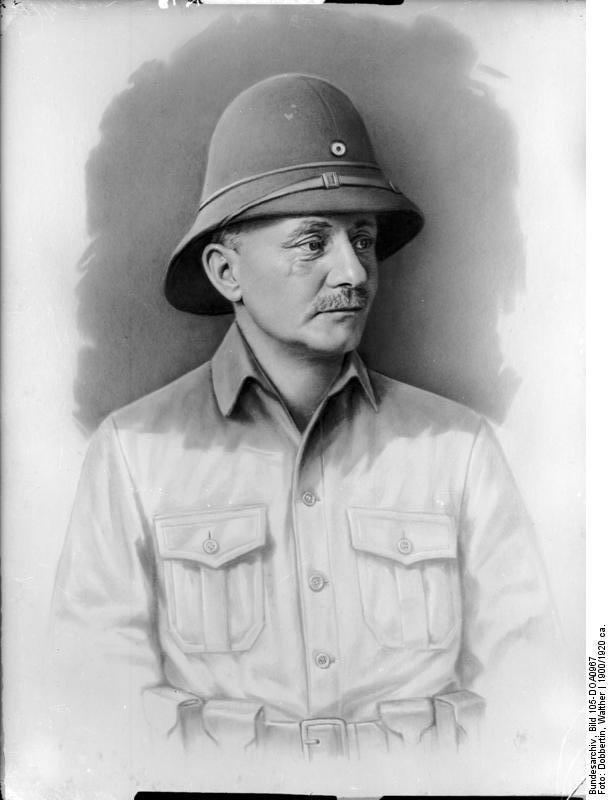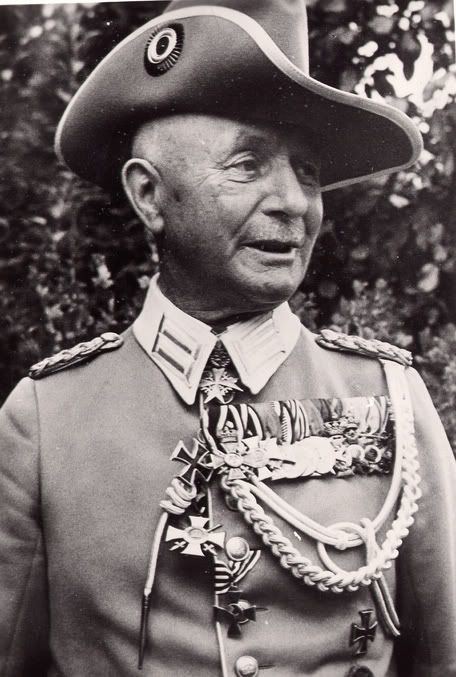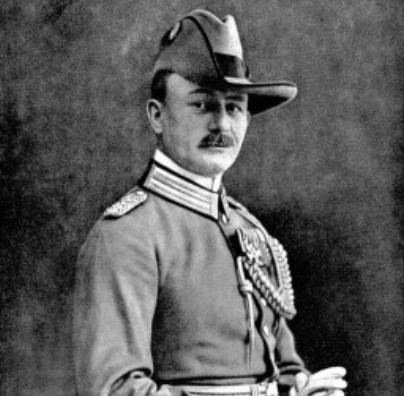Years of service 1890–1920 Awards Pour le Merite Role Military Commander | Name Paul Lettow-Vorbeck | |
 | ||
Nickname(s) Der Lowe von AfrikaThe Lion of Africa Unit 4th Foot GuardsSchutztruppe of GermanSouth-West AfricaXI Corps Books My reminiscences of East Africa People also search for | ||
The lion of africa paul von lettow vorbeck i who did what in ww1
Paul Emil von Lettow-Vorbeck (20 March 1870 – 9 March 1964), nicknamed affectionately as the Lion of Africa (German: Löwe von Afrika), was a general in the Prussian Army and the commander of its forces in the German East Africa campaign. For four years, with a force that never exceeded about 14,000 (3,000 Germans and 11,000 Africans), he held in check a much larger force of 300,000 British, Belgian, and Portuguese troops. Essentially undefeated in the field, Lettow-Vorbeck was the only German commander to successfully invade imperial British soil during the First World War. His exploits in the campaign have been described by Edwin Palmer Hoyt "as the greatest single guerrilla operation in history, and the most successful." Others have pointed out that it was a a campaign of supreme ruthlessness where a small, well trained force extorted supplies from civilians to whome it felt no responsibility...it was the climax of Africa's exploitation. Lettow's tactics led to famine that killed thousands of Africans and weakened the population, leaving it vulnerable to influenza epidemic in 1919
Contents
- The lion of africa paul von lettow vorbeck i who did what in ww1
- Paul von lettow vorbeck
- Early life
- Military career
- First World War
- East African war and the population
- Post war career
- Legacy
- In popular culture
- Works
- References

Paul von lettow vorbeck
Early life

Paul Emil von Lettow-Vorbeck was born into the Pomeranian minor nobility, while his father was stationed as an army officer at Saarlouis in the Prussian Rhine Province. He was educated in boarding schools in Berlin and joined the corps of cadets at Potsdam and Berlin-Lichterfelde. In 1890, he was commissioned a Leutnant into the Imperial German Army.
Military career

In 1900, Lettow-Vorbeck was posted to China as a member of the international alliance forces to quell the Boxer Rebellion. He did not like fighting against guerrillas and considered the war detrimental to the discipline of the German Army. He returned from China in 1901 and became a member of the German General Staff.

Beginning in 1904, he was assigned to German South-West Africa (now Namibia), during the Namaqua and Herero insurrection. He did not participate in the subsequent genocide: having suffered injuries to his left eye and chest, he was evacuated to South Africa for treatment and recovery.
In 1907, Lettow-Vorbeck was promoted to Major and assigned to the staff of 11th Army Corps. From March 1909 to January 1913, he was commanding officer of the marines of II. Seebataillon ("2nd Sea Battalion") at Wilhelmshaven, Lower Saxony, German Empire. In October 1913, the Imperial German army promoted him to Lieutenant Colonel and appointed him to command the German colonial forces known as the Schutztruppe (protectorate force) in German Kamerun (today's Cameroon, plus a portion of present-day Nigeria). Before he could assume this command, however, his orders were changed and he was posted — with effect from 13 April 1914 — to German East Africa (Tanganyika, the mainland territory of present-day Tanzania).
While travelling to his new assignment, Lettow-Vorbeck formed what would prove to be a lifelong friendship with Danish author Karen Blixen (also known by her pen name of Isak Dinesen), who was travelling aboard the same liner. Decades later, she recalled, "He belonged to the olden days, and I have never met another German who has given me so strong an impression of what Imperial Germany was and stood for."
First World War
Lettow-Vorbeck's plan for the war was quite simple: knowing that East Africa would only be a sideshow to the other theatres of war, he determined to tie down as many British troops as he could. He intended to keep them away from the Western Front, and in this way to contribute to Germany's eventual victory.
In August 1914, during the early phases of the First World War, Lettow-Vorbeck was the commander of a small military garrison of just 2,600 German nationals and 2,472 African soldiers in fourteen Askari field companies. Realising the need to seize the initiative, he disregarded orders from Berlin and the colony's Governor, Heinrich Schnee, who had attempted to achieve neutrality for German East Africa. Lettow-Vorbeck simply ignored the Governor and prepared to repel a major British amphibious assault on the city of Tanga. The attack began on 2 November 1914, and for the next four days the German forces fought one of their greatest engagements, the Battle of Tanga. Lettow-Vorbeck then assembled his men and their scant supplies to attack the British railways in East Africa. He scored a second victory over the British at Jassin on 19 January 1915. These victories gave him badly needed modern rifles and other supplies, as well as a critical boost to the morale of his men.
However, Lettow-Vorbeck also lost many experienced men, including the "splendid Captain Tom von Prince", whom he could not easily replace.
Lettow-Vorbeck knew he could count on his highly motivated officers (their casualty rate was certainly proof of that). Although casualties remained high, Lettow insisted his commanders engage British forces. Unfortunately, the British offered few enticing targets, and forced him to conduct raids into British East Africa (later Kenya, Uganda, and Zambia), targeting forts, railways, and communications, all with the goal of forcing the Entente to divert manpower from the main theater of war in Europe. He realized the critical needs of guerrilla warfare, in that he used everything available to him in matters of supply.
The Schutztruppe recruited new personnel and expanded to its eventual size of some 14,000 soldiers, most of them Askaris, and all well-trained and well-disciplined. Lettow-Vorbeck's fluency in the Swahili language earned the respect and admiration of his African soldiers; he appointed black officers and "said — and believed — [that] 'we are all Africans here'." In one historian's estimation, "It is probable that no white commander of the era had so keen an appreciation of the African's worth not only as a fighting man but as a man."
He gained the men and artillery of the German cruiser SMS Königsberg (scuttled in 1915 in the Rufiji River delta) which had a capable crew under commander Max Looff, as well as numerous guns which were converted into artillery pieces for the land fighting, the largest standard land artillery pieces used in the East African theater. In March, 1916, the British under General J. C. Smuts launched a formidable offensive with 45,000 men and the Belgians under General Charles Tombeur near Tabora. Lettow-Vorbeck patiently used climate and terrain as his allies, while his troops fought the British on his terms and to his advantage. The British, however, kept adding more troops and forcing Lettow-Vorbeck to yield territory. Nevertheless, he fought on, including a pivotal battle at Mahiwa in October 1917, where he lost 519 men killed, wounded, or missing and the British, 2,700. After the news of the battle reached Germany, he was promoted to Major-General (Generalmajor). The British would recover their losses and continue to hold an overwhelming advantage in numbers of men. For the Schutztruppe, this was serious: there were no reserves to fill the ranks again.
Lettow-Vorbeck then began a forced withdrawal to the south, with his troops on half rations and the British in pursuit. On 25 November 1917, his advance column waded across the River Rovuma into Portuguese Mozambique. In essence, Lettow-Vorbeck cut his own supply lines, and the Schutztruppe caravan became a nomadic tribe. On its first day across the river, it attacked the newly replenished Portuguese garrison of Ngomano and solved all its supply problems for the foreseeable future. When it captured a river steamer with a load of medical supplies, including quinine, at least some of its medical problems were no more. For almost a year Lettow-Vorbeck's men had now lived off the land, but mainly with provisions captured from the British and Portuguese; they had replaced their old rifles with new equipment and acquired machine guns and mortars after capturing Namakura (Nhamacurra in modern Mozambique) in July, 1918. At the end of the War, they still had more ammunition than they could carry.
On 28 September 1918, Lettow-Vorbeck again crossed the Rovuma River and returned to German East Africa with the British still in pursuit. He then turned west and raided Northern Rhodesia, thus evading a trap the British had prepared for him in German East Africa. On 13 November 1918, two days after the armistice, he took the town of Kasama, which the British had evacuated, and continued heading south-west towards Katanga. When he reached the Chambeshi River on the morning of 14 November, the British magistrate Hector Croad appeared under a white flag and delivered a message from the allied General Jacob van Deventer, informing him of the armistice. Lettow-Vorbeck agreed to a cease-fire at the spot now marked by the Chambeshi Monument in present-day Zambia. He was instructed by the British to march north to Abercorn (now Mbala) to surrender his undefeated army, which he did, arriving there on 25 November. His remaining men then consisted of just thirty German officers, 125 German non-commissioned officers and other enlisted ranks, 1,168 Askaris, and some 3,500 porters.
East African war and the population
The British and Belgian invasions of German East Africa set off a chain of events with devastating ramifications for the natives and their German overlords. The invasions caused interruptions throughout the colony, so that the land no longer "basked in a climate of plenty."
As military commander, Lettow-Vorbeck's first obligation was to his army, over the objections of Governor Heinrich Schnee: the governor regarded war as the worst possible calamity that could befall German East Africa; it would "undo everything his social and economic reforms had accomplished." Lettow-Vorbeck knew he would have to give ground and escape confrontations with Allied forces. He thus established food depots along his intended line of march from Neu Moshi to the Uluguru Mountains, and if the neighboring villages were near starvation, that was a misfortune of war.
Scarcely any aid from Germany could penetrate the British naval blockade to alleviate the enormous supply deficiencies, and only two ships running the blockade succeeded in reaching the colony. On 14 April 1915, the freighter Kronborg arrived off Tanga at Manza Bay after a two months' journey from Wilhelmshaven and was promptly attacked by the British cruiser HMS Hyacinth. Fortunately for the Germans, Kronborg had been scuttled by her captain to avoid a coal fire after repeated hits by the British cruiser, and the ship settled in shallow water; nearly her entire cargo could be salvaged. But when the steamer Marie von Stettin arrived south of Lindi on 17 March 1916, its cargo of 1,500 tons was of only very modest help. An attempt in November 1917 to resupply German forces by Zeppelin airship failed. By late September 1916, all of coastal German East Africa, including Dar es Salaam and the Central Railway, was under British control, with the west of the colony occupied by Belgian forces. Then, in December 1917, the German colony was officially declared an Allied protectorate.
Lettow-Vorbeck and his caravan of Europeans, Askaris, porters, women, and children marched on, deliberately bypassing the tribal home lands of the native soldiers in an effort to forestall desertions. They traversed difficult territory: "swamps and jungles . . . what a dismal prospect there is in front of me", stated the Allied commander, General J. C. Smuts. But Smuts did not flinch. His new approach and objective was not to fight the Schutztruppe at all, but to go after their food supply. The end eventually came, with Smuts in London and Gen. J. L. van Deventer in command in East Africa.
In a book published in 1919, Ludwig Deppe, a doctor of medicine who campaigned with Lettow-Vorbeck and who had formerly headed the hospital at Tanga, looked back ruefully and lamented the tragedy that German forces had imposed on East Africa in their war with the invading Allies: "Behind us we leave destroyed fields, ransacked magazines and, for the immediate future, starvation. We are no longer the agents of culture, our track is marked by death, plundering and evacuated villages, just like the progress of our own and enemy armies in the Thirty Years' War." Edward Paice estimates 365,000 civilians died from famine and disease. When the worldwide Spanish influenza epidemic swept into eastern Africa in 1918–1919, it struck down thousands of natives and Europeans. The weakened state of many natives made them especially susceptible; this included the caged Askaris and porters of the German Schutztruppe in prisoner-of-war camps at Tabora.
Post-war career
After hostilities ended, the British transferred the German soldiers and POWs to Dar es Salaam for eventual repatriation. Lettow-Vorbeck tried to ensure decent treatment and an early as possible release for the German Askaris imprisoned at Tabora.
Lettow-Vorbeck returned home to Germany in early March 1919 to a hero's welcome. On a black charger he led 120 officers of the Schutztruppe in their tattered tropical uniforms on a victory parade through the Brandenburg Gate, which was decorated in their honour. Though he ultimately surrendered as ordered, he had frequently won against great odds and was the only German commander to invade British territory successfully during the First World War.
Lettow-Vorbeck was greatly respected by his white officers, non-commissioned officers and Askaris, and even Allied forces. In the field when rations had to be reduced and supplies dwindled,
"it was a measure of the Askaris' loyalty to their commander that they accepted the cuts and did not desert en masse. Some did desert, of course … [as did British, Belgian and Portuguese native troops]. But the German Askaris were by far the most loyal as well as the most effective, and it all went back to… Lettow-Vorbeck's brand of discipline, which bound him and his German officers as much as his black soldiers".Michael von Herff says the loyalty of Askaris during the campaign had little to do with Von Lettow's character or his 'brand of discipline', but we due to them having formed a military caste within the colonial structure, who had largely separated themselves from tribal roots.
One of Lettow-Vorbeck's junior officers, Theodor von Hippel, used his experience in Africa to be instrumental in forming the Brandenburgers, the commando unit of the German Abwehr intelligence agency in the Second World War.
After his return from Africa, Lettow-Vorbeck married Martha Wallroth (1884–1953) in 1919; they had two sons – Rüdiger (1921–1940) and Arnd (1922–1941) – and two daughters – Heloise (1923) and Ursula (1927). Many people tried to get him involved in the chaotic politics of the Weimar Republic. He remained in the Army. Only fourteen months after his return to Germany, Lettow-Vorbeck commanded the troops that ended (without any use of force) the Spartacist uprising in Hamburg. In the confusion following the Kapp Putsch at about the same time, Lettow-Vorbeck lost his commission in the army in the summer of 1920. He then worked in Bremen as an import-export manager.
In June 1926, Lettow-Vorbeck met Colonel Richard Meinertzhagen in Bremen, the British Intelligence officer with whom he had fought a battle of wits until Meinertzhagen was invalided back to England in December 1916 (he was later posted to Palestine). Three years later, Lettow-Vorbeck accepted an invitation to London, where he met face-to-face for the first time J. C. Smuts; the two men formed a lasting friendship. When Smuts died in 1950, Lettow-Vorbeck sent his widow a moving letter of sympathy.
A similar oft-quoted claim states that Lettow-Vorbeck also apologized for the "ungentlemanly death" of the British hunter Frederick Selous at the hands of one of his snipers; this claim, however, is not supported by contemporary evidence.
Between May 1928 and July 1930, the former General served as a Reichstag deputy for the monarchist German National People's Party. He intensely "distrusted Hitler and his movement," and approached his relative Hans-Jürgen von Blumenthal with an idea to form a coalition with the Stahlhelm against the Nazis. This resulted in the Vorbeck-Blumenthal Pact. Later, when Hitler offered him the ambassadorship to the Court of St James's in 1935, he "declined with frigid hauteur."; the suggestion for the nomination as ambassador to the Court of St James had come from retired Colonel Richard Meinertzhagen during a visit to Berlin. During the 1960s, Charles Miller asked the nephew of a Schutztruppe officer, "I understand that von Lettow told Hitler to go fuck himself." The nephew responded, "That's right, except that I don't think he put it that politely."
After his blunt refusal, Lettow "was kept under continual surveillance" and his home office was searched. The only rehabilitation due to his legendary status among the German people came in 1938, when at the age of 68 he was promoted to the rank of General for Special Purposes, but he was never recalled to active service.
By the end of the Second World War in 1945, Lettow-Vorbeck was destitute. His two sons, Rüdiger and Arnd, had both been killed in action serving in the Wehrmacht. His house in Bremen had been destroyed by Allied bombs, and he depended for a time on food packages from his friends Meinertzhagen and Smuts. However, with the German economic miracle, he began to enjoy comfortable circumstances again. In 1953, he visited his former home, East Africa, where he was heartily welcomed by surviving Askaris, who greeted him with their old marching song Heia Safari! and was also received with military honours by British colonial officials.
In 1964, eleven days before his 94th birthday, Paul von Lettow-Vorbeck died in Hamburg. The West German government and the Bundeswehr flew in two former Askaris as state guests, so that they could attend the funeral of their general. Several officers of the Bundeswehr were assigned as an honour guard, and West Germany's Minister of Defence, Kai-Uwe von Hassel, gave the eulogy, saying that the deceased, "was truly undefeated in the field". Paul von Lettow-Vorbeck was buried in Pronstorf, Schleswig-Holstein, in the graveyard of Vicelin Church.
Legacy
In the year of Lettow-Vorbeck's death, 1964, the West German Bundestag voted to give back-dated pay to all surviving Askaris from the German forces of the First World War. A temporary cashier's office was set up in Mwanza on Lake Victoria. Of the 350 old soldiers who gathered, only a handful could produce the certificates that Lettow-Vorbeck had given them in 1918. Others presented pieces of their old uniforms as proof of service. The German banker who had brought the money had an idea: each claimant was asked to step forward, was handed a broom and was ordered in German to perform the manual of arms. Not one man failed the test.
Four barracks of the Federal German Army, or Bundeswehr, were once named in his honour. They were situated at Leer, Hamburg-Jenfeld, Bremen, and Bad Segeberg. Following the recent closure of 178 military installations, the only one remaining is the Lettow-Vorbeck-Kaserne in Leer, East Frisia. The former Hamburg-Jenfeld barracks houses the "Tanzania Park", a group of large terracotta relief sculptures of Lettow-Vorbeck and his Askari soldiers, now closed to the public. Another sculpture of Lettow-Vorbeck and the Askaris is on display at Mühlenteich, near the Bismarck memorial at Friedrichsruh.
In the spring of 2010, the City Council of Saarlouis renamed Von Lettow-Vorbeck-Straße, mainly for Lettow-Vorbeck's involvement in the 1920 Kapp Putsch. In Hanover, "Lettow-Vorbeck Straße" was renamed "Namibia Straße". In Wuppertal, Bremen, Cuxhaven, Mönchengladbach, Halle, Radolfzell and Graz, Austria there are still streets named after General von Lettow-Vorbeck, while in Radolfzell a procedure for renaming the road is nearing completion.
The dryosaurid species Dysalotosaurus lettowvorbecki was named after Lettow-Vorbeck.
In popular culture
Lettow-Vorbeck appears in a 1993 episode of the television series The Young Indiana Jones Chronicles. The episode, which was titled "The Phantom Train of Doom", begins with Indiana Jones as an officer in the Belgian Army during the First World War. Determined to destroy a Schutztruppe armored train, Indiana takes General von Lettow-Vorbeck (played by Tom Bell) hostage and attempts to return with him behind Allied lines. When the Schutztruppe tracks them down, Indy draws his revolver in order to shoot the general, but ultimately decides to let him go. The general magnanimously gives him a compass and the two part as friends.
Lettow-Vorbeck is the protagonist of The Ghosts of Africa, a 1980 historical novel by Anglo-Canadian novelist William Stevenson about the East African Campaign which highlighted the long-distance resupply mission of the giant German rigid airship L.59.
Lettow-Vorbeck also appears as a character in Peter Høeg's short story, "Journey into a Dark Heart", which is the opening story in his 1990 collection, Tales of the Night. In this story Høeg imagines Lettow-Vorbeck travelling through Africa by train at night accompanied by Joseph Conrad.
Much of the history of Lettow-Vorbeck's war campaign in East Africa is detailed in the book Speak Swahili, Dammit! (2011) by James Penhaligon, as well as in a novel of the same year, The Bridge Builders (Brobyggarna in Swedish) by Jan Guillou.
A German film, Lettow-Vorbeck: Der deutsch-ostafrikanische Imperativ, was produced in 1984.
